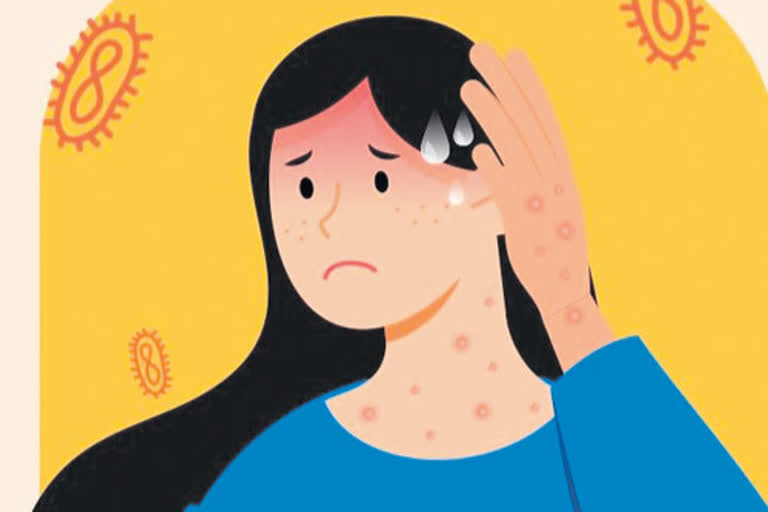Hyderabad: Even before COVID scourge is completely over, new diseases are emerging. Things that were limited to some regions are now making their way to other countries. The latest addition to this is the outbreak of monkeypox similar to smallpox. Two months ago, monkeypox was limited to West and Central African countries. But now, it has already covered 72 countries. The World Health Organization has recognised it as an urgent public health problem. And, the government of India has also issued guidelines to curb monkeypox.
Dr. M V Rao, General Physician, Yashoda Hospitals, Hyderabad shares a comprehensive article on the precautions and preventions of monkeypox based on his research findings. The virus was born somewhere in Africa and then entered America and Europe. It has even spread to India with four monkeypox cases officially registered in one month. So far it is limited to those who have come from abroad. If not prevented in the beginning, it can become widespread.
It has been confirmed that one person in Delhi has contracted monkeypox even though he had no travel history in the past. Similar to respiratory viruses, it is spread through droplets, but with sexual contact. It is a relief that it is not as severe and fatal as smallpox. It's also not a disease like covid. Moreover, the fact that many of us are taking the smallpox vaccine, which has long-lasting effects against monkeypox, is reassuring.
Also read: Explainer: What is known about monkeypox
Monkeypox is an animal-to-human disease. Its source is the monkeypox virus. It is a virus belonging to the genus Paxviridae. It is mainly found in some types of rodents, rats, monkeys, and chimpanzees. It was first identified in 1958 in monkeys specifically for research purposes. That is why it was named Monkeypox. It was first discovered in Congo in 1970 by humans. After that, it spread to Central and West African countries. About 3% of those affected have died. Limited to African countries, it spread to America in 2003 through prairie dogs. It is rapidly spreading to many countries including Europe. A large number of cases are now coming to light in Africa as well.
Monkeypox virus is spread from animals to humans by scratching or biting infected mice and squirrels. They can get infected by touching their saliva and blood. Like respiratory viruses in humans, it is spread from person to person through droplets produced when coughing and sneezing. Otherwise, with large droplets, it is possible to infect people who have been in close contact with monkeypox for a long time. Body secretions such as saliva and blisters can also be contagious through direct contact. Infected people can also infect others with used blankets, clothes, teeth, and spoons. There is a risk of the monkeypox virus infecting the fetus of pregnant women.
A polymerase chain reaction (PCR) test can detect the presence or absence of the virus. If it is positive, a conventional PCR to detect monkeypox or a PCR test to detect monkeypox DNA is done. Genome analysis is required to determine virus patterns. Monkeypox usually goes away on its own. There are no ill effects on health in the long run. However, it can be serious for children, people with weak immunity, people with other problems such as diabetes, and pregnant women. It depends on the effect of the virus, health status, and other diseases. Experience has shown that only 0-11% of people infected with monkeypox die. Its mortality rate seems to be around 3-6 percent. But having the smallpox vaccine is a plus. Once the smallpox vaccine was given to everyone and because of this, we were able to end smallpox in 1977. This vaccine also combats monkeypox and provides long-term protection. It means that even if you took the smallpox vaccine 50 years ago, you can still get protection. However, smallpox vaccination was stopped in 1980. Therefore, those born after that are more likely to get monkeypox.
Monkeypox is treated according to its symptoms. Antiviral drugs used in the treatment of smallpox are also useful for this. In case of sores, care should be taken such as wiping with an antiseptic solution, keeping it clean, tying a bandage lightly, and avoiding touching and scratching. Antibiotics are useful if it becomes a bacterial infection. People with genital blisters get relief if they pour warm water into a tub and sit in it for a while. If the mouth is sore, gargling with salt water and pain-relieving ointments are good.
- Drinking enough water is important. Drinking water mixed with ORS powder is even better. Also, take good nutrition. If necessary, saline should be added to infected patients.
- If there is fever, wiping with a wet cloth and paracetamol tablets is useful. Calamine ointment and antihistamines are good to relieve itching.
People with suspected monkeypox symptoms must stay away from others and must wear a mask. Blisters should be covered with a thin cloth. No one in the house should touch bedding, blankets, clothing, or towels that have been touched by people with monkeypox infections. Frequent washing of hands with soap or alcohol-based hand sanitizer is a must. This can ensure that the disease does not spread to others. Smallpox vaccine also prevents monkeypox. So, in America and Europe, they have started giving it to prevent monkeypox.
Eye pain or blurred vision, fatigue, difficulty in breathing, chest pain, loss of consciousness, fainting, and loss of urine means that the condition is getting worse. Such people should be immediately admitted to the hospital and treatment should be started. Monkeypox should be suspected by symptoms alone. Most of the symptoms are similar to smallpox. Symptoms can start anytime between 6-13 days after being infected with the virus. For some, it may appear within 5 days, but for some, it may not appear for up to 21 days.
